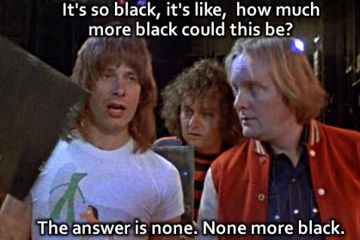What I’ve Learned:
“Albedo: upon further reflection, it keeps getting better.”
I used to think “albedo” was a term for sex drive in people without skin pigmentation. This led to some very uncomfortable conversations. And, as someone who doesn’t tan very well, a lot of unsuccessful pickup lines.
As it turns out, albedo means something a little bit different. It’s another word for “reflection coefficient”, which is the ratio of light reflected off an object to the amount of light pumped in. For a highly shiny object — Gwyneth Paltrow’s forehead, say — then you have a high albedo, close to 1. On a much darker surface — where light rays check in, but they don’t check out — the albedo will be very close to zero.
A partial list of substances on the low end of the albedo scale:
A 7-11 asphalt parking lot: 0.12
Charcoal: 0.04
Vantablack carbon nanotube substance: 0.00035
C. Montgomery Burns’ shriveled heart: 0.002
Black hole: 0(-ish)
Spinal Tap’s Smell the Glove album (revised cover): 0.000000001
(How much more black could it be? The scientific answer is: negligibly more black, allowing for measurement variability and prevailing experimental conditions. Nigel Tufnel wasn’t so far off.)
The albedo of most objects is affected by two things: the angle and the wavelength of light streaming in. Light glancing past is easier to reflect, and some materials have a preference for absorbing or bouncing back light of various colors.
In fact, that’s how we perceive objects as having colors; we only see the wavelengths bouncing off them that they neglected to absorb. If every substance sucked up every wavelength of light like some kind of solar paper towel, then they’d all be completely black.
Unlike non-solar paper towels, which are white. Because the Brawny man will clean up your coffee spills. But he’ll never take away your sunshine.
In astronomy, albedo is an important characteristic of faraway objects, and can be used to determine what they’re made of. One of Saturn’s moons, Enceladus, has a surface of nearly pristine ice, and an albedo of 0.99. You could basically use Enceladus as a mirror to see if there’s spinach stuck between your teeth, except that its 750 million miles from your bathroom and your face would freeze if you got anywhere close to it.
This week’s flyby — or more accurately, screamingwhooooshby — of Pluto by the New Horizons spacecraft is providing details and answers to a question first raised by albedo measurements of Pluto and its largest moon, Charon. These bodies (as well as Pluto’s other moons) are thought to have formed from a collision of two large objects many millions of years ago. But looking at light reflected from them, Pluto has an albedo in the range of 0.49 – 0.66, while Charon is much darker, at 0.36 – 0.39.
Why the difference? Are the two made of different substances, after all? Did somebody polish Pluto up to try to get it reinstated as a planet? Or is Charon just going through a “goth” phase?
These are answers that albedo alone can only hint at, for objects at the edge of our solar system and for planets many, many light years away. It’s not a perfect tool for astronomical discovery — but for the places our probes (and horny albinos) can’t reach, it’s an awfully good start.



